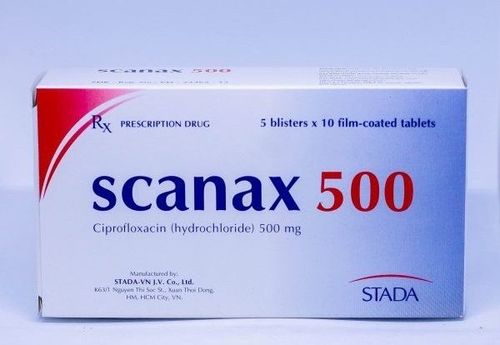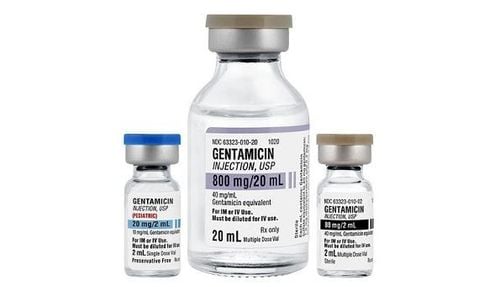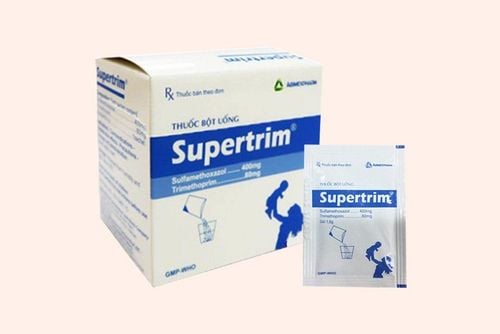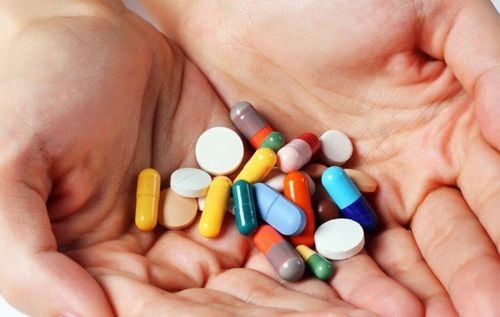This is an automatically translated article.
Scanax medicine (Ciprofloxacin) is usually indicated for severe infections for which conventional antibiotics do not work, for example: urinary tract infections, prostatitis, severe infectious enteritis, osteomyelitis - marrow, severe nosocomial infections (bacteremia, infection prophylaxis, meningococcal disease in immunocompromised people).
1. What is the effect of Scanax?
Scanax medicine contains the active ingredient Ciprofloxacin, an antibiotic belonging to the Fluoroquinolone group (Quinolone 2nd generation) with an antibacterial mechanism based on inhibition of Enzyme gyrase and topoisomerase IV (enzymes necessary for the regeneration process). bacterial DNA).Ciprofloxacin has a broader pharmacokinetics and antibacterial spectrum than nalidixic acid (1st generation Quinolone antibiotic) and is therefore approved for use in systemic infections.
So what disease does Scanax cure? To avoid the development of bacteria that are resistant to Ciprofloxacin, Scanax is indicated in severe infections for which conventional antibiotics are ineffective, for example:
Prostatitis ; Urinary tract infections ; Osteoarthritis - marrow; Severe inflammatory bowel infections; Severe nosocomial infections (bacteremia, infections in immunocompromised patients); Prophylaxis of meningococcal disease in immunocompromised patients.
2. Instructions for using Scanax
2.1. Dosage Scanax is prepared in the form of tablets with the content of Ciprofloxacin 500mg. Based on the treatment purpose, the recommended daily dose of the drug is as follows:
Treatment of upper urinary tract infections: 250-500mg x 2 times; Treatment of infections in skin, soft tissue and bone: 500 - 700mg x2 times; Treatment of severe nosocomial infections, bacteremia, infections in immunocompromised people: 500-750mg x 2 times; Uncomplicated gonorrhea: a single dose of 500mg; Treatment of chronic prostatitis, severe infectious enteritis: 500mg x 2 times; Prophylaxis of severe bacterial enteritis and meningococcal disease: a single dose of 500 mg (for children > 20 kg: 500 mg; children < 20 kg: 250 mg); Prevention of Gram-negative infections in immunocompromised patients: 250-500mg x 2 times. (*Note: Dosage reduction should be considered in patients with impaired liver function or severe renal impairment. No dose reduction is necessary in patients with mild renal impairment if low doses are used; higher doses should be used. adjusted based on creatinine clearance or serum creatinine concentration).
2.2. Dosage The best time to take Scanax is about 2 hours after a meal. Patients should take the drug with plenty of water and should not take an anti-acid stomach medicine within 2 hours after taking Scanax.
For most infections, treatment usually lasts 1-2 weeks. For severe infections with complications or bone and joint infections, treatment may last 4-6 weeks or longer.
(* Note: Patients need to adhere to the full duration of antibiotic treatment. Even if there are no symptoms, the medication should continue for at least 48 hours).

Giải đáp Scanax 500 là thuốc gì?
3. Side effects of drugs
In some cases, the drug Scanax can change the laboratory parameters and affect the central nervous system, digestion, blood circulation, metabolism, liver, muscles, skin...
One Some of the side effects of Scanax may include:
Common side effects:
Diarrhea, abdominal pain, nausea and vomiting; Transaminase levels increase temporarily. Uncommon side effects:
Fever, drug headache; Fast heart beat; agitation; Digestive disorders; Urticaria, rash; Joint pain, joint swelling; Serum creatinine, bilirubin, alkaline phosphatase levels increase temporarily; Eosinophilia, polymorphonuclear leukopenia, lymphocytopenia, thrombocytopenia, anemia. Rare side effects:
Anaphylactic reactions; Convulsions, confusion; Psychosis, paranoia; Sleep disturbance, peripheral psychosis, depression; Visual disturbances, hearing loss, hallucinations, tinnitus; Disorders of smell and taste, increased intracranial pressure; Pseudomembranous colitis ; Skin-mucosal syndrome, Lyell's syndrome, erythema nodosum, erythema multiforme exudate; Some cases of hepatocellular necrosis, hepatitis, cholestatic jaundice; Muscle pain, inflammation of the tendons of the heel and surrounding tissue; Test of alkaline urine, crystalluria, hematuria, interstitial nephritis, acute renal failure; Hemolytic anemia, increased platelets, white blood cells, changes in Prothrombin levels; Sensitivity to light with sun exposure, pulmonary edema, laryngeal edema, dyspnea, bronchospasm. When seeing unwanted side effects, patients should stop using Scanax and talk to their doctor to be considered to change to another more suitable drug.
4. Note before using the drug
Contraindicated to use Scanax for the following cases:
Patients sensitive to active ingredient Ciprofloxacin, other drugs of the Quinolone group or to any of its ingredients; The patient is taking the drug Tizanidine; Scanax should be used with caution in patients with epilepsy, history of central nervous system disorders, renal failure, G6DP deficiency or myasthenia gravis.
Other notes:
Should stop taking the drug if the patient has signs of pain, inflammation or herniated ligament; Avoid excessive exposure to sunlight or bright light during the period of treatment with Scanax 500; Avoid co-administration of Scanax with other fluoroquinolone-containing drugs while treating staphylococcal skin infections (MRSA) because of the high degree of resistance; The drug may cause the TB bacilli test to be negative; Limit the use of Ciprofloxacin antibiotic in young children and growing children because many studies show that the drug has a risk of causing cartilage degeneration in young animals; Pregnant women should only use Scanax in case of severe infections that other antibiotics cannot treat, requiring Fluoroquinolone; The drug can be excreted in breast milk and affect a nursing baby, so women who are breastfeeding should stop this activity if they must take Scanax 500mg; Scanax medicine may reduce the ability to operate machinery, drive dangerous when manipulating.

Tiêu chảy, đau bụng là tác dụng phụ của thuốc Scanax 500
5. Scanax drug interactions
Some drugs that can interact with drugs include:
Cloroquin; Fenbufen; Naproxen; Antacids containing magnesium or aluminum; Anticoagulants such as Warfarin; Salts of calcium, iron, zinc; Theophylline; Glibenclamide; Ciclosporin; Cytotoxic drugs such as: Cyclophosphamide, Vincristine, Doxorubicin, Cytosine Arabinoside, Mitoxantrone; Didanosine; Sucralfate. Hopefully, the article has provided readers with the information they need to know to answer the questions "What is Scanax 500?", "What disease does scanax treat?" and oriented to use drugs effectively during their treatment.
Follow Vinmec International General Hospital website to get more health, nutrition and beauty information to protect the health of yourself and your loved ones in your family.
Please dial HOTLINE for more information or register for an appointment HERE. Download MyVinmec app to make appointments faster and to manage your bookings easily.













